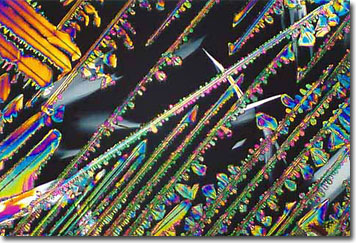Loes Modderman
Tartaric Acid-Urea Mixture
Tartaric acid occurs in one of three salt forms: Cream of tartar, tartar emetic, and Rochelle salt. Interestingly, the crystals of Rochelle salt have electric properties (piezoelectric), and they are employed as part of the conducting components in some microphones. In purified form, tartaric acid produces crystals that typically have no smell, but possess a taste that is very slightly sour.

A common ingredient in ceramics, photographic chemicals, and mirror silvering, tartaric acid is also utilized in tanning, and polishing products. Sodium bicarbonate is used in combination with this white, powdery substance to enable quick dissolution of active ingredients in antacid preparations, as well as to put effervescent fizz in some beverages. In addition, as a component of baking powders, esters of tartaric acid impart a smoother texture to finished goods such as fudge and taffy.
Urea is the terminal product of nitrogen metabolism in most mammals, and it was the first animal metabolite to be isolated in crystallized form. In 1773, scientists discovered that urea releases ammonia when heated, and in 1828, urea was the first organic compound to be synthesized from inorganic materials.
Toxic ammonia is converted into urea within the liver. Although the highest concentrations of urea are found in urine, the compound is present in other body fluids as well, such as blood. Urea is transported in the blood to the kidneys, and then excreted via urine.
Concentrations of urea in the body will fluctuate throughout the day, and there are several factors that affect these levels. For instance, dietary intake of protein will tend to increase urea levels, while frequent urination will decrease urea levels. Concentrations of this compound in the blood tend to be highest after meals.
As a favorite ingredient for fertilizers, urea contains higher nitrogen content than the alternatives (46 percent). In addition, it produces few pollutants, and fire hazard is minimal. In granulated form, urea is hard, and more resistant to moisture, so most gardeners prefer to use the granules, as opposed to other available forms. Urea is also a common ingredient for skin care products, as it binds moisture to skin, reducing itching, cracking, and roughness. Additionally, the compound is used in the manufacture of plastics, as well as a variety of pharmaceuticals.
BACK TO LOES MODDERMAN GALLERY
